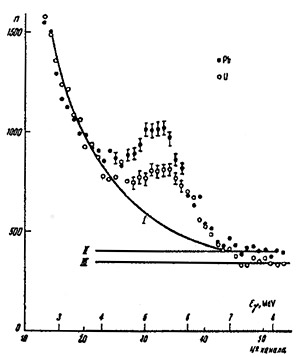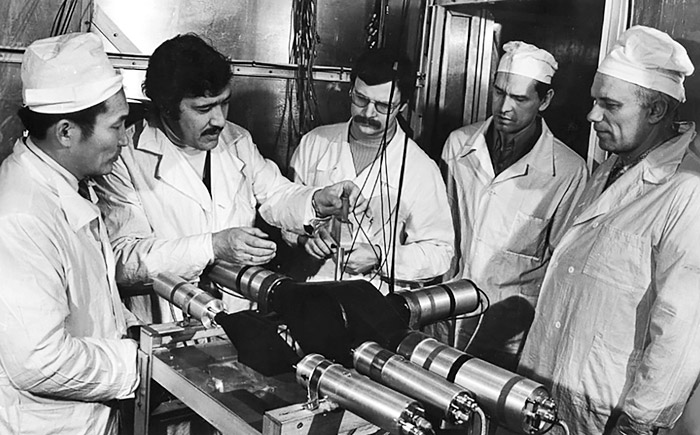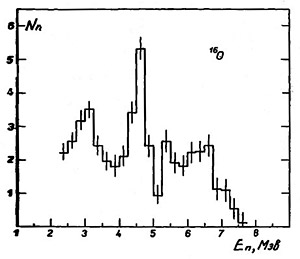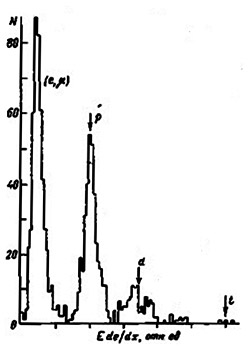
Electronic english version since 2022 |
The newspaper was founded in November 1957
| |
Horizons of scientific search
Muons and Nuclei, or The Adventures of the Muon in the Nucleus
Mark Twain, refuting information about his death, remarked: "The rumors about my death are somewhat exaggerated." But rumors about the "death" of the DLNP accelerator turned out to be quite reliable, although new research facilities are currently developed in the laboratory. Gone is the glorious era of heated discussions, boiling ideas and overwhelming enthusiasm for implementing experiments on beams of protons, muons and pions. Every Thursday, in the DLNP conference hall, the division of beam time for the next week took place and a serious struggle for accelerator time ensued. The leader of each experiment demonstrated miracles of eloquence and logic in the belief that his experiment was the most interesting and it was in it that the fate of modern physics was decided. As a result, almost everyone received time, but less than what they claimed. This means that in order to save precious acceleration time, they had to live and prepare the experiment in the first building for the entire allotted time for preparing and implementing measurements. Everyday problems were somehow solved: the shower was functioning, there was some kind of refrigerator, one shabby sofa for everyone, on which they slept for 2-3 hours at a time. But everyone was happy - no one noticed the inconvenience! The main thing is the operation of the equipment and measurement! The separated muon beam in the low-background laboratory was available thanks to the reliable work of the group of secondary beams supervised by V.S.Roganov.
MUON PHYSICS has its own peculiarity and advantage - during the research process, the experimenter can work and deal with an individual muon. The mu meson was discovered in cosmic rays in 1936 and named mesotron by analogy with the positron, discovered in 1933. It was interesting in that it turned out to be a highly penetrating particle and passed through significant layers of matter, losing energy only to ionization. After the discovery of the π-meson and the process of π→μ decay, the mesotron as a secondary particle was called the μ-meson. In 1936-1937, the π→μ→е decay reaction was discovered and the basic properties of μ-mesons were established.
Since 1948-1949, the second period has started in the experimental research of the properties of μ-mesons, concerning the use of accelerators. Beams of μ-mesons produced at accelerators allowed to obtain new results. Thus, the spectroscopy of meso-X-ray radiation of μ-mesonic atoms was developed that gave impetus to the development of extensive investigations of mesoatomic and mesonuclear processes and the interesting phenomenon of μ-meson catalysis of the fusion reaction of a proton and deuteron was discovered.
At the end of 1956, a new period started in the physics of μ-mesons: the occurrence of longitudinal polarization in the μ-meson was discovered that allowed to measure its magnetic moment and afterwards, the depolarization property of the muon spin allowed to carry out a huge range of investigations of the nuclear, atomic and even chemical properties of matter. The problem of depolarization is closely related to the discovery of a new hydrogen-like atom consisting of a μ+-meson and an electron, called muonium. At the same time, it was confirmed with great accuracy that μ-mesons and electrons interact with the electromagnetic field absolutely identically and thus the μ-meson was called a heavy electron. All known mesons are participants in strong interactions and the μ-meson - only in weak ones. Therefore, it is customary to use the name muon, heavy electron instead of the μ-meson. And that means muonic atoms, as well.
All of the above-mentioned problems and properties of muons have been widely and comprehensively studied at the Laboratory of Nuclear Problems using muon and pion beams from the phasotron.
 PRODUCTION of a muonic atom occurs when a muon stops in a substance in a very short (almost instantaneous) time, while the muon remains in the K-orbit of the muonic atom and its stay ends with decay or nuclear capture. Muons captured by the electric field of the nucleus, when moving to a lower energy level, emit energy quanta, the so-called meso-X rays, similar to x-rays in simple atoms. As a result of such a transition, its energy can be emitted in the form of a gamma quantum, but can be transferred in heavy elements to the nucleus and cause excitation and fission of the nucleus. This fission process was called radiation-free. The investigation of this process was carried out by the famous theorist David Fischerovich Zaretsky that loved to utter the famous phrase "I am a simple man, I speak in verse" when he was praised.
PRODUCTION of a muonic atom occurs when a muon stops in a substance in a very short (almost instantaneous) time, while the muon remains in the K-orbit of the muonic atom and its stay ends with decay or nuclear capture. Muons captured by the electric field of the nucleus, when moving to a lower energy level, emit energy quanta, the so-called meso-X rays, similar to x-rays in simple atoms. As a result of such a transition, its energy can be emitted in the form of a gamma quantum, but can be transferred in heavy elements to the nucleus and cause excitation and fission of the nucleus. This fission process was called radiation-free. The investigation of this process was carried out by the famous theorist David Fischerovich Zaretsky that loved to utter the famous phrase "I am a simple man, I speak in verse" when he was praised.
The uranium-238 nucleus is considered as an example. These calculations were displayed by Zaretsky in the "Reports of Soviet scientists at the II International Conference on the peaceful use of atomic energy" in Geneva, in 1958. According to calculations, the probability of non-radiative transitions in a uranium mesoatom, where the density of nuclear levels is high, should be significant (5÷20). In a lead mesoatom with a low density of nuclear levels (magic nucleus), this probability is zero. Based on these calculations, a group of physicists headed by Bruno Pontecorvo carried out an experiment to measure the difference in the yields of the corresponding radiative X-ray transitions in U and Pb. Bruno Maksimovic always strived for simplicity in everything. So, in this experiment, the idea was original and simple: measuring the difference in the yields of the corresponding radiative X-ray transitions in uranium and lead with one detector under the same conditions. An experimental result was obtained in which a clear difference in the spectra of meso-X-ray radiation from uranium and lead was observed by a value of ~0.2. The significance of this discovery is based primarily on the discovery of a new electromagnetic process in mesoatoms. This mechanism was discussed in detail at the IV International Conference on High Energy Physics and Nuclear Structure, held in 1971, in Dubna.
The discovery was included in the State Register of Discoveries of the USSR under No. 100 with priority dated 17 June, 1959. The discovery formula reads: "The previously unknown property of mesoatoms has been established to transfer without radiation the entire meson transition energy to the nucleus when it is close to the difference in the energies of nuclear levels."
It is INTERESTING now to trace the fate of the μ-meson after nuclear fission. One of the possible results of a radiation-free transition of a muon in a heavy mesoatom may be the fission of the atomic nucleus (instantaneous fission). This raises the question: what is the probability of detecting a muon on a light or heavy fragment after fission? According to a theoretical paper, this probability of detecting a muon on light and heavy fragments was assumed to be 10% and 90%, respectively, in another paper, the estimate was 50% and 50%. In the paper of Yu.N.Demkov and his colleagues (LSU), using the binding energy of a muon in the field of a finite-size nucleus, the average probability of detecting a muon on a light fragment was 1% and therefore, 99% - on a heavy one.
In the occurrence of a bound muon on a heavy fragment, a resonance process of radiation-free ejection of the muon into an excited state, followed by a mesoatomic radiative transition, is possible. An experimental investigation and search for these meso-X-ray lines was carried out at the University of Bonn (Germany) by the group of Professor P.David. From the USSR, on the initiative of S.M.Polikanov, Fedor Karpeshyn (LSU) was invited to this "hunt" as the author-theorist of this process and B.Sabirov (JINR) as an experimenter with an experience in working with muons. Fitting of the estimated meso-X-ray total spectrum from the fragment was undertaken with the FIT programme using a Gaussian function. The position of the conglomerate was determined to be 3910±40 keV with a width of 640±110 keV (full width at half maximum). The intensity of this conglomerate relative to the fission intensity observed during flash fission was determined to be (6.0±2.1)%. Thus, it is stated that meso-X-ray radiation has been detected from a fission fragment during the non-radiative fission of uranium in mu-capture.

In the photo (from left to right): Shovodoin Gerbish, B.M.Sabirov, Wolfgang Mayer, G.G.Semenchuk, G.E.Solyakin.
Photo by Yury TUMANOV
In 1950, B.M.PONTECORVO suggested that the interaction of the mu-meson with the nucleus can be described by analogy with K-capture in nuclear β-decay by the reaction р+μ→ n+v, in which a proton turns into a neutron with the emission of neutrinos. For a long time, it was believed that the absorption of the mu-minus-meson using the nucleus occurs due to its interaction with only one of the protons of the nucleus and all other nucleons of the nucleus act only as an external environment. In 1963, a group of theorists from the SINP MSU and the Laboratory of Theoretical Physics JINR, headed by MSU Professor V.V.Balashov, put forward a fundamentally different model of this process that was based on the idea that the absorption of a muon using a nucleus has a multiparticle collective character. A mathematical theory of the phenomenon has been developed and areas for its experimental research have been indicated. The main channel for the capture of μ-mesons using nuclei is the channel with the emission of a neutron. The particle-proton hole interaction in the residual nucleus results in a collective excited state of the nucleus - a giant resonance. The neutron energy spectra calculated within the framework of this approach have a characteristic line shape.
 |
| Energy spectrum of neutrons from the nuclear μ--capture reaction in oxygen |
Thus, in experiments carried out under the supervision of V.S.Evseev, a line structure was discovered in the spectra of neutrons emitted during the absorption of negative muons. The reliability of the discovery was confirmed by the results of the research of American and Western European physicists.
The discovery was included in the State Register of Discoveries of the USSR under No.173 in the following formulation: "A previously unknown phenomenon of resonance absorption of negative muons using atomic nuclei has been established that consists in the fact that when negative muons are absorbed, collective excitation of atomic nuclei occurs." The priority of the discovery was established on two dates: 22 October, 1963 (theoretical justification), 8 October, 1968 (experimental confirmation).
 The process of absorption of muons through collective states such as giant resonance can also result in the emission of charged particles. The line structure of the spectrum of charged particles will appear less clearly than in the case of neutrons. In order to measure the energy spectra of charged particles during mu-capture in light nuclei, V.G.Zinov (DLNP) designed an experimental facility with the following capabilities: separation of charged particles by mass; measurements of absolute energy spectra of protons, deuterons and tritium nuclei. As a result of the research, the following conclusions were made: the greater the mass of a charged particle, the less likely it is to escape and therefore, only protons and deuterons practically occur in the spectra; within the limits of error, the measured spectra of protons from sulfur and calcium nuclei are consistent with the neutron spectra measured in the USA, but differ quite significantly from the spectra given in the paper of V.S.Evseev.
The process of absorption of muons through collective states such as giant resonance can also result in the emission of charged particles. The line structure of the spectrum of charged particles will appear less clearly than in the case of neutrons. In order to measure the energy spectra of charged particles during mu-capture in light nuclei, V.G.Zinov (DLNP) designed an experimental facility with the following capabilities: separation of charged particles by mass; measurements of absolute energy spectra of protons, deuterons and tritium nuclei. As a result of the research, the following conclusions were made: the greater the mass of a charged particle, the less likely it is to escape and therefore, only protons and deuterons practically occur in the spectra; within the limits of error, the measured spectra of protons from sulfur and calcium nuclei are consistent with the neutron spectra measured in the USA, but differ quite significantly from the spectra given in the paper of V.S.Evseev.
ALL THE CONSIDERED above processes cause excitation during cascade transitions of the muon (resonance or non-radiative) and μ-capture using the nucleus. The third solution to the fate of the muon that fell into the sphere of influence of the nucleus, remained unnoticed by all "muon scientists," although the possibility of muon decay in the K-orbit of the muonic atom was indirectly, as if in passing, mentioned. An experiment to search for this process was brewing inevitably. Since a muon with orbital momentum l=0 creates a spherically symmetric electromagnetic field around the nucleus, its instantaneous removal causes an electromagnetic shake-up of the nucleus and it explains the process in which predominantly monopole excitation of the nucleus should occur. The main goal of the experiment is to detect gamma radiation from the corresponding excited level of the nucleus in coincidence with an electron from the decay of a muon in the K-orbit of a muonic atom that will serve as evidence of the occurrence of a third type of nuclear excitation during mu-capture. Theoretical estimates of the probability of excitation of the lowest 0+ level for the samarium-152 nucleus gave the value w≤3·10-4. In 1976, the author of this article proposed this experiment to the discoverer of radiation-free muon capture Academician B.M.Pontecorvo. The proposal was accepted and supported. The experiments were carried out at the muon beams of the Leningrad Nuclear Physics Institute, Gatchina and DLNP JINR. Due to the imperfection of the detection equipment and electronics of those times, only the upper limit of the probability of the process w<5·10-3 was obtained. The results allow us to hope for the successful development of future research in this area. Obviously, this experiment should be repeated, significantly improving the detection equipment so that measurements with large statistics can be carried out under very low background conditions.
Basar SABIROV,
DLNP researcher